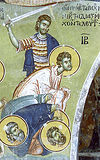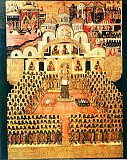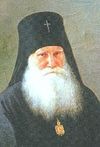

| Previous day | Next day |
| Old Style
October 12
|
Sunday |
New Style
October 25
|
| 20th Sunday after Pentecost. Tone 3. | No fast.
|
![]() Martyrs Probus, Tarachus, and Andronicus, at Tarsus in Cilicia (304).
Martyrs Probus, Tarachus, and Andronicus, at Tarsus in Cilicia (304). ![]() St. Cosmas the Hymnographer, bishop of Maiuma (ca. 787).
St. Cosmas the Hymnographer, bishop of Maiuma (ca. 787).
Martyr Domnina of Anazarbus (286). St. Martin the Merciful, bishop of Tours (397). Sts. Amphilochius (1452), Macarius (1480), and Tarasius (1440), abbots, and Theodosius, monk (15th c.), of Glushitsa Monastery (Vologda), disciples of St. Dionysius of Glushitsa. Translation from Malta to Gatchina: of a Particle of the Life Giving Cross, the Filersk Icon of the Mother of God, and the relic of the Right Hand of John the Baptist (1799). St. Arsenius, archimandrite, of Svyatogorsk Monastery (1859). St. Euphrosyne (Mezenova) the Faster, schema-abbess, of Siberia (1918). Glorification of St. Philaret, archbishop of Chernigov (2009).
New Hieromartyr Lawrence (Levchenko), hieromonk, of Optina Monastery (1937). New Hiero-confessor Nicholas (Mogilevsky), metropolitan of Alma-Ata (1955).
“Jerusalem” (48) and “Kaluga” (1748) Icons of the Most Holy Theotokos.
Hieromartyr Maximilian, bishop of Noricum (284). St. Mobhi of Glasnevin (Ireland) (544). Martyr Edwin, king of Northumbria (633). St. Wilfrid, bishop of York (709). Translation of the relics of St. Sabbas the Sanctified from Rome to Jerusalem (1965). Virgin-martyr Anastasia of Rome (ca. 250). St. Theodotus, bishop of Ephesus. St. Jason, bishop of Damascus. St. Symeon the New Theologian [transferred from Great Lent, March 12] (1022). St. Theosebius the God-bearer, of Arsinoe on Cyprus.
Thoughts for Each Day of the Year
According to the Daily Church Readings from the Word of God
By St. Theophan the Recluse

Twentieth Sunday After Pentecost. [Gal. 1:11-19; Luke 7:11-16]
The Lord sees a mother weeping over the death of her son and has compassion on her; another time he was called to a marriage, and rejoiced together with the family. By this He showed that to share ordinary everyday joys and sorrows is not contrary to His spirit. This is what true, reverent Christians do, who live their life in fear [of God]. However, they distinguish some everyday life routines from others; for much has entered into these routines which cannot be God’s good will. There are customs that come from passions, which arise for their indulgence; others are kept alive by vanity and busyness. He who has the spirit of Christ, will be able to distinguish the good from the bad: he adheres to the one and rejects the other. He who does this with the fear of God is not alienated by others, though he does not act like them, because he always acts in the spirit of love and compassion toward the infirmities of his brothers. Only a spirit of zeal beyond measure rubs people the wrong way and produces disharmony and division. Such a spirit cannot refrain from teaching and criticizing. But the [one with the spirit of Christ] is only concerned with ordering his and his family’s life in a Christian way; he does not permit himself to interfere in the affairs of others, saying to himself, “Who set me as a judge?” He quietly makes everyone well disposed to himself, and inspires respect for those routines to which he holds. A supervisor makes himself unloved, and evokes disapproval for the good routines to which he holds. Humility in such cases is needed—Christian humility. It is the source of Christian good sense, which knows how to act well in a given situation.
Articles
 Martyrs Probus, Tarachus, and Andronicus, at Tarsus in CiliciaThe Martyrs Tarachus, Probus, and Andronicus suffered for Christ in the year 304 at Tarsus in Cilicia. |
 Martyr Domnina of AnazarbusThe Martyr Domnina of Anazarbus lived in the region of Cilicia, and suffered for confessing Christianity. |
 Venerable Amphilochius the Abbot of GlushetsaSaint Amphilochius, Abbot of Glushetsa, already a monk of priestly rank, came from Ustiug to Saint Dionysius of Glushetsa (July 1) in the year 1417. |
 “Jerusalem” Icon of the Mother of GodThe Jerusalem Icon of the Mother of God, by tradition, was painted by the holy Evangelist Luke fifteen years after the Ascension of the Lord at Gethsemane. |









